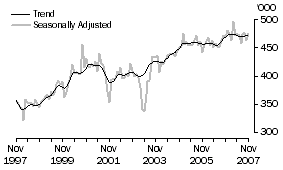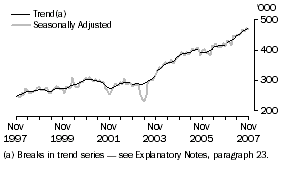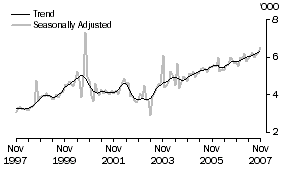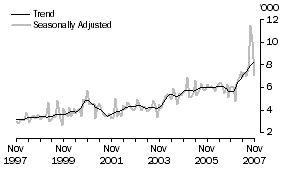MAIN FEATURES
SHORT-TERM VISITOR ARRIVALS
In trend terms, short-term visitor arrivals to Australia during November 2007 (471,500 movements) changed little compared with October 2007 (470,900 movements). Currently, short-term visitor arrivals are 0.5% higher than in November 2006.
SHORT-TERM VISITOR ARRIVALS

The following table presents the top ten source countries (based on original estimates) for short-term visitor arrivals during November 2007. Seasonally adjusted and trend estimates are also presented for these countries, along with the percentage change in trend compared with October 2007 and November 2006.
Short-term Visitor Arrivals, Major Source Countries - November 2007 |
|  |
 | Trend | Seasonally Adjusted | Original | Oct 07 to Nov 07 | Nov 06 to Nov 07 |  |
 | '000 | '000 | '000 | Trend % change | Trend % change |  |
|  |
| New Zealand | 93.7 | 96.6 | 95.1 | -0.3 | 2.4 |  |
| United Kingdom | 56.7 | 56.3 | 66.0 | - | -6.9 |  |
| Japan | 46.6 | 44.5 | 49.9 | -0.8 | -11.8 |  |
| United States of America | 39.8 | 39.5 | 37.8 | 1.2 | 5.0 |  |
| China | 31.4 | 31.9 | 35.1 | 1.4 | 14.4 |  |
| Singapore | 21.8 | 22.8 | 29.1 | -0.2 | -2.0 |  |
| Korea | 20.3 | 20.2 | 21.3 | -1.1 | -12.8 |  |
| Malaysia | 13.1 | 15.1 | 16.6 | 1.8 | -1.2 |  |
| Germany | 12.2 | 12.2 | 14.0 | -1.1 | -1.1 |  |
| Hong Kong | 12.5 | 12.8 | 10.4 | 0.1 | -3.5 |  |
|  |
| - nil or rounded to zero (including null cells) |
SHORT-TERM RESIDENT DEPARTURES
In trend terms, short-term resident departures (469,600 movements) increased by 0.5% compared with October 2007 (467,100 movements). Short-term resident departures are currently 10.8% higher than in December 2006, when a trend break was introduced - see Explanatory Notes, paragraph 23.
SHORT-TERM RESIDENT DEPARTURES

The following table presents the top ten destinations (based on original estimates) for short-term resident departures during November 2007. Seasonally adjusted and trend estimates are also presented for these countries, along with the percentage change in trend compared with October 2007 and November 2006.
Short-term Resident Departures, Major Destinations - November 2007 |
|  |
 | Trend | Seasonally Adjusted | Original | Oct 07 to Nov 07 | Nov 06 to Nov 07 |  |
 | '000 | '000 | '000 | Trend % change | Trend % change |  |
|  |
| New Zealand | 77.3 | 77.6 | 71.6 | -0.1 | 4.4 |  |
| United States of America | 41.9 | 41.5 | 37.2 | 1.2 | 14.8 |  |
| Thailand | 30.9 | 32.0 | 33.5 | -1.1 | 18.6 |  |
| Indonesia(a) | 23.5 | 24.9 | 23.6 | 1.9 | 63.4 |  |
| Hong Kong | 18.1 | 18.5 | 22.4 | 1.6 | 9.3 |  |
| United Kingdom | 36.3 | 35.4 | 22.0 | - | 7.9 |  |
| China | 24.3 | 24.8 | 21.8 | 0.5 | 14.1 |  |
| Singapore | 19.4 | 19.3 | 19.3 | 0.1 | 14.8 |  |
| India | 10.2 | 10.0 | 18.0 | -1.8 | 7.4 |  |
| Fiji | 18.0 | 17.6 | 16.1 | 1.8 | 12.1 |  |
|  |
| - nil or rounded to zero (including null cells) |
| (a) Break in trend series from December 2006 - see Explanatory Notes, paragraph 23. |
PERMANENT AND LONG-TERM MOVEMENTS
There were 12,510 permanent (settler) arrivals to Australia during November 2007, an increase of 9.2% compared with November 2006 (11,460 movements). People born in the United Kingdom accounted for the largest proportion of settlers (18%), followed by people born in New Zealand (14%), India (9%) and China (8%).
There were 5,460 Australian residents departing permanently from Australia during November 2007, an increase of 6.6% compared with November 2006 (5,120 movements).
Statistics on overseas arrivals and departures relate to the number of movements of travellers rather than the number of travellers. Care should be taken when using long-term movements data as it is known that some individuals who travel multiple times in a year are counted each time they cross Australia's borders (see paragraph 5 of the Explanatory Notes). Long-term movements in this publication are not an appropriate source of migration statistics. For further information refer to Australian Demographic Statistics (cat. no. 3101.0) and Information Paper: Statistical Implications of Improved Methods for Estimating Net Overseas Migration, Australia, 2007 (cat. no. 3107.0.55.005).
SHORT-TERM TRAVEL - FRANCE
Short-term visitor arrivals
Trend estimates provide the best method to analyse the underlying direction of the short-term visitor arrivals series for France. Over the ten year period ending November 2007, the trend estimated has varied. Prior to mid-2002 the trend fluctuated. From that period the trend series has shown strong and consistent growth. The high point in the series was the current month (6,300 movements) and the low point was in March 1998 (3,200 movements). Currently, the number of movements in November 2007 is 10% higher than in November 2006.
The seasonally adjusted series allows for the analysis of irregular impacts on the series. The graph below shows that over the ten years ending November 2007, two large variations are evident for short-term visitor arrivals to Australia from France. The large increases in the seasonally adjusted series were due to sporting events being held in Australia: the Olympic Games in Sydney in September 2000 and the Rugby World Cup in November 2003.
FRANCE, Short-term visitor arrivals

In original terms, in the year ended November 2007 short-term visitor arrivals from France represented 1.3% (72,600 movements) of all short-term visitor arrivals to Australia. This proportion was slightly higher than in the previous 12 months (1.2%, or 67,500 movements) and higher than in the twelve months ended November 1997 (0.9%, or 39,500 movements).
In the year ended November 2007, short-term visitor arrivals from France stated holiday (55%) as the main reason for journey, followed by visiting friends and relatives (16%) and business (12%). In comparison the main reasons for journey for all short-term visitors to Australia were holiday (50%), visiting friends and relatives (21%) and business (11%). The median age of short-term visitors from France was 34 years (39 years for all short-term visitor arrivals), and the median duration of stay was 17 days (10 days for all short-term visitor arrivals).
The states of New South Wales (52%), Victoria and Queensland (16% each) and Western Australia (9%) were the main states/territories of intended stay for short-term visitor arrivals from France in the year ended November 2007. The main destinations for all short-term visitor arrivals to Australia were New South Wales (39%), Queensland (27%), Victoria (18%) and Western Australia (10%).
Short-term resident departures
Trend estimates provide the best method to analyse the underlying direction of the short-term resident departures series for France. While the trend series over the ten year period ending November 2007 has fluctuated, it has generally followed an upward trend. There were long periods of relative stability with the series showing strong and consistent growth from January 2007. The high point in the series was the current month (8,300 movements) and the low point was in January 1998 (3,100 movements). Currently, the number of movements is 48% higher than in November 2006.
The seasonally adjusted series, which allows for the analysis of irregular impacts on the series, shows a large peak in September 2007 which coincides with the 2007 Rugby World Cup being held in France.
FRANCE, Short-term resident departures

In original terms, in the year ended November 2007 short-term resident departures to France represented 1.7% (92,700 movements) of all short-term resident departures from Australia. This was higher than the proportion for the previous twelve months (1.5%, or 72,200 movements) and for the twelve months ended November 1997 (1.2%, or 34,600 movements).
In the year ended November 2007, short-term resident departures to France stated holiday (67%) as the main reason for journey, followed by visiting friends and relatives (11%) and business (9%). In comparison the main reasons for journey for all short-term residents departing Australia were holiday (49%), visiting friends and relatives (24%) and business (14%). The median age of short-term resident departures to France was 46 years (42 years for all short-term resident departures), and the median duration of stay was 29 days (15 days for all short-term resident departures).
STATISTICAL SIGNIFICANCE
The above presentation of movements in estimates does not take into account whether the change in movement is statistically significant. Care should be taken when interpreting the impact of numeric and/or percentage change. Please see the Standard Errors section of this issue for more detail.
 Print Page
Print Page
 Print All
Print All